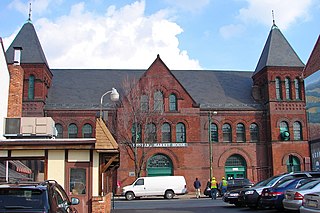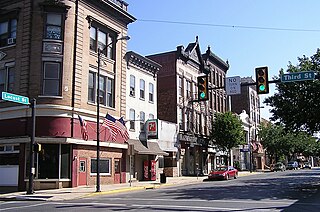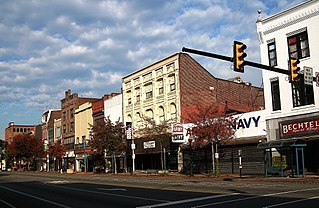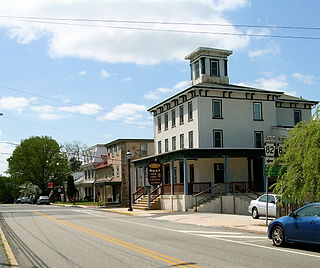
The Hinton Historic District is a national historic district located at Hinton, Summers County, West Virginia. The original Hinton Historic District is bordered roughly by the Chesapeake and Ohio Railroad line, James Street, 5th Avenue, and Roundhouse. The boundary increase extended the district to include Mill Street. It was listed on the National Register of Historic Places in 1984 and revised in 2005.

The Roaring Spring Historic District is a national historic district that is located in Roaring Spring, Blair County, Pennsylvania.

The Tyrone Borough Historic District is a national historic district that is located in Tyrone, Blair County, Pennsylvania.

The Williamsburg Historic District is a national historic district that is located in Williamsburg, Blair County, Pennsylvania.

Bellefonte Historic District is a national historic district located at Bellefonte, Centre County, Pennsylvania. The district encompasses 296 contributing buildings in the central business district and surrounding residential area of Bellefonte. The oldest building in the district is the Col. James Dunlop House dated to 1795. Notable non-residential buildings include the St. John's Roman Catholic Church, Crider Exchange (1889), Temple Court Building (1894), First National Bank Building, W.F. Reynolds and Co. Bank Building, and Pennsylvania Railroad Station. Located in the district and listed separately are the Brockerhoff Hotel, Centre County Courthouse, Gamble Mill, McAllister-Beaver House, and Miles-Humes House. The Bellefonte Academy and the Bush House Hotel were previously listed on the register until they burned to the ground in 2004 and 2006, respectively.

Mount Union Historic District is a national historic district located at Mount Union in Huntingdon County, Pennsylvania. The district includes 58 contributing buildings, 3 contributing sites, and 1 contributing structure in the central business district and surrounding residential areas of Mount Union. Notable buildings include the Federal-style John Shaver House (1818), Shapiro Theater (1915), T.A. Appleby Store and House, Kenmar Hotel, Penn Central National Bank (1916), Peduzzi's and the Weller Building (1913-1914), Pennsylvania Railroad Freight Depot (1914), St. Luke's Evangelical Lutheran Church (1904-1905), First United Methodist Church (1925-1926), St. Catherine of Siena Roman Catholic Church (1912-1913), Mount Union Elementary School (1923-1924), and U.S. Post Office (1936). The contributing sites include the I.O.O.F. community cemetery, founded in 1872, and the former Victoria Park. Located in the district and listed separately is the Harbison-Walker Refractories Company complex.

The Revloc Historic District is a national historic district located at Cambria Township in Cambria County, Pennsylvania.

The Red Lion Borough Historic District is a national historic district that is located in Red Lion Borough in York County, Pennsylvania.

The York Historic District is a national historic district that is located in the central business district and surrounding residential areas of York in York County, Pennsylvania. It is situated north of the Springdale Historic District.

The Newville Historic District is a national historic district which is located in Newville, Cumberland County, Pennsylvania. The district is bordered roughly by Cove Alley, Big Spring Creek, the right-of-way for the Cumberland Valley Railroad, and Washington Street, and encompasses 414 contributing buildings, one contributing site, and two contributing objects in the central business district and surrounding residential areas of Newville.

Chambersburg Historic District is a national historic district centered on the Memorial Fountain and Square of Chambersburg in Franklin County, Pennsylvania. The district includes 159 contributing buildings in the central business district and immediately surrounding residential area of Chambersburg. The district has a number of notable examples of Georgian and Italianate style architecture. Notable buildings include the St. Paul United Methodist Church (1896), Professional Arts Building, Cumberland Valley National Bank, Cumberland Valley Railroad Station, First United Brethren Church (1899), firehouse, Presbyterian Church of the Falling Spring (1803), and the Suesserott House. Located in the district and separately listed are the Franklin County Jail, Franklin County Courthouse, John Brown House, Masonic Temple, Townhouse Row, and the Zion Reformed Church.

The Manheim Borough Historic District is a national historic district that is located in Manheim, Lancaster County, Pennsylvania.

Columbia Historic District is a national historic district located at Columbia, Lancaster County, Pennsylvania. The district includes 833 contributing buildings, 2 contributing sites, and 7 contributing structures in the central business district and surrounding residential areas of Columbia. The district is primarily residential with notable examples of Late Victorian architectural styles. Notable non-residential buildings include the Reading and Columbia Freight Station (1883), Holy Trinity Catholic Church and School (1915), American Legion Post 469, Women's Club, Columbia Lodge #1074 BPOE, Columbia Town Hall, St. Paul's Episcopal Church (1888), Franklin Hotel, and Columbia Water Company. Located in the district is the separately listed Bachman and Forry Tobacco Warehouse.

The Old Pottstown Historic District is a national historic district that is located in Pottstown, Montgomery County, Pennsylvania.

The Tamaqua Historic District is a national historic district that is located in Schuylkill Township and Tamaqua, Schuylkill County, Pennsylvania.

The Lewisburg Historic District is a national historic district that is located in Lewisburg, Union County, Pennsylvania.

The Ligonier Historic District is a national historic district that is located in Ligonier, Westmoreland County, Pennsylvania.

The Scottdale Historic District is a national historic district that is located in Scottdale, Westmoreland County, Pennsylvania.

Elverson Historic District is a national historic district located in Elverson, Chester County, Pennsylvania. The district includes 133 contributing buildings, 3 contributing sites, and 4 contributing structures in the central business district and surrounding residential areas of Elverson. The district includes a variety of residential, commercial, and institutional buildings with examples of Bungalow/craftsman, Georgian, and Gothic Revival architecture. Contributing buildings date from about 1750 to about 1930. Notable buildings include "The Bank House", train station (1870), Springfield M.E. Church (1869), Blue Rock Hotel (1860), Dengler Bro. Store, Whoye Horse Tavern (1811), The Creamery (1906), and Springfield School (1873). One of the contributing structures is the railroad car "Baltimore County."

Plymouth Historic District is a national historic district located in Plymouth, Washington County, North Carolina. The district encompasses 258 contributing buildings, 5 contributing sites, and 1 contributing structure in the central business district and surrounding residential sections of Plymouth. It was largely developed between about 1880 and 1930 and includes notable examples of Colonial Revival, Bungalow / American Craftsman and Late Victorian style architecture. Located in the district are the separately listed Latham House, Perry-Spruill House, and Washington County Courthouse. Other notable buildings include the Hornthal-Owens Building, Blount Building, Atlantic Coast Line Railroad Station (1923), Davenport-Davis House, Robert Ward Johnston House (1924), Latham-Brinkley House (1883), Plymouth United Methodist Church and Cemetery, Grace Episcopal Church and Cemetery designed by Richard Upjohn, New Chapel Baptist Church (1924), Agricultural Building (1936-1937) constructed through the Works Progress Administration, Plvmouth Railroad Station (1927), Brinkley Commercial Block (1926), and Clark-Chesson House.
























